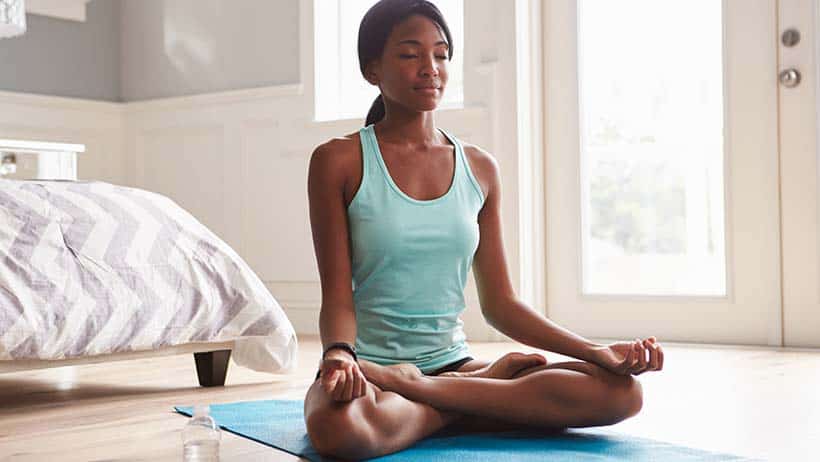
Every yoga pose, known in Sanskrit as an “asana,” has its own way of bringing the body and mind into greater harmony. World-renowned yoga teacher B.K.S. Iyengar poetically compares the body to a bow and each asana to the various arrows with which individuals target the ultimate aim of yoga practice — the soul.
About the Pose
पद्मासन
Padmasana
People often use this classic sitting pose for meditation and pranayama yoga. Many cultures — particularly Buddhism and Hinduism — consider the lotus flower a spiritual symbol. This aquatic flower blooms from the bottom of a muddy lake, representing humble beginnings and beautiful potential. Its many petals also reveal an opening of the spirit and body. No wonder this flower inspires an asana that helps practitioners reach the highest consciousness. Expand on that inspiration and let this calming pose clear your head so you can meditate on the gift that is the present moment.
Level: Intermediate (While it may seem like a simple sitting pose, lotus pose requires ankle flexibility.)
Key Benefits:
- Increases flexibility in the feet and ankles
- Lengthens the spine
- Stretches the hips
- Inspires a calm mindset, especially during meditation
Specific Cautions:
- Individuals suffering from a knee, ankle, calf, or spine injury should avoid this pose.
- In addition, those with sciatica should skip this pose.
Related Poses:
- Hero Pose (Virasana): This beginner pose builds strength and endurance while easing tension in the hip joints, knees, groin, and the entire upper torso.
- Staff Pose (Dandasana): This beginner pose opens the chest, corrects posture, reduces heartburn and flatulence, and tones the leg muscles.
- Bound Angle Pose (Baddha Konasana): This beginner pose aids in the treatment of urinary tract disorders, helps prevent hernias, and promotes overall health in both gender’s genitalia and pelvic regions.
Recommended: Browse more of our guides on the art and practice of yoga to harmonize your body, mind, and soul.
Trying It Out
Remember to keep your breathing full and steady as you follow these step-by-step instructions to try this pose out for yourself:
Step One
Start in a cross-legged sitting position on the floor. Straighten your spine and rest the backs of your hands on your knees. Don’t slouch.
Step Two
Grab your right foot with both hands and gently lift it onto your left thigh. The bottom of your foot should face upward.
Step Three
Grab your left foot with both hands and gently lift it onto your right thigh.
Step Four
Hold this position and breathe mindfully for as long as it remains comfortable.
Refining the Pose
Achieving maximum benefit from your yoga practice requires you to pay close attention to your physical alignment. To ensure you maintain proper alignment, ask yourself these questions:
- Are your back and shoulders straight?
- Is your head drooping?
- Is your right knee pressed to the floor?
- Are your feet resting high up on your thighs?
- Is your upper body perpendicular to the floor?
- Are your hands relaxed on your knees?
Variations:
- Half Lotus Pose (Ardha Padmasana): This beginner variation only involves lifting the right foot onto the left thigh.
- Half Lotus Pose Raised Arms (Ardha Padmasana Raised Arms): This variation, which also involves lifting just the right foot onto the left thigh, includes the addition of interlocking the fingers and raising the arms above the head. The palms of the hands should face the sky and stretch gently upward.
- Blossoming Lotus Pose (Vikasita Kamalasana): This advanced variation engages the core while a practitioner hooks their arms beneath their knees and lifts their legs so they balance on their sitz bones.
- Bound Lotus Pose (Baddha Padmasana): Another advanced variation, this involves moving the hands behind the back to hold either the opposite elbows or the opposite toes.
- Elevated Lotus Pose (Utthita Padmasana): This intermediate variation provides an opportunity to test your arm and shoulder strength as you push yourself off the ground to suspend yourself in the air while remaining seated in lotus pose.
- Upward Lotus Pose (Urdhva Padmasana): This advanced variation starts in the shoulder stand pose (sarvangasana). After you remove your hands from the floor, slowly fold your legs into the lotus pose and push your hands against your thighs or knees to maintain your balance.